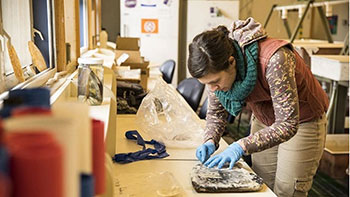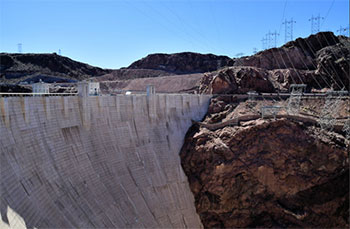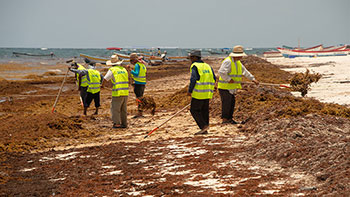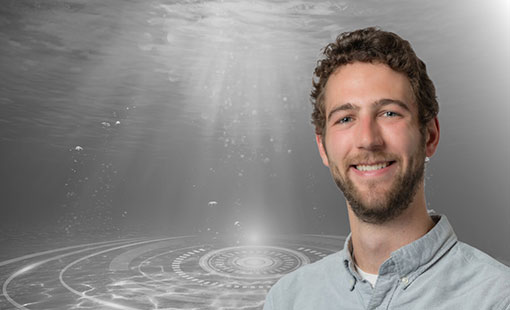NREL Water Power Newsletter, The Current, Spring 2024
In this issue, learn about NREL's water power science, technology, engineering, and math portfolio, explore Water Power Technologies Office accomplishments featuring NREL, catch up on hydropower and marine energy news, and more
This quarterly newsletter highlights the latest from NREL's Water Power Program.
Subscribe to Newsletter
To receive quarterly updates about NREL water power news, accomplishments, events, and more, subscribe to The Current newsletter.
In This Issue
Science, Technology, Engineering, and Math Spotlight
NREL Featured in Water Power Technologies Office Accomplishments Report
Science, Technology, Engineering, and Math Spotlight
SPLASH Into Our New Science, Technology, Engineering, and Math Newsletter
The SPLASH (Student-Professional Learning and Sharing Hub), NREL’s new quarterly newsletter, highlights news from our science, technology, engineering, and math (STEM) programs.
By subscribing to The SPLASH, you will dive into:
- STEM education and workforce materials by NREL, industry partners, and other U.S. Department of Energy national laboratories
- Water power collegiate competition updates and application information
- Announcements of upcoming events, funding opportunities, and new resource releases
- And much more.
Application Period Open for 2025 Marine Energy and Hydropower Collegiate Competitions
College students are invited on YouTube to take a deep dive into the marine energy and hydropower industries through two exciting annual competitions—which are now accepting applications. The competitions provide students with resume-boosting experience, a closer look at high-potential water power fields, industry connections, and a chance to win cash prizes. The third annual American Made Challenges Hydropower Collegiate Competition and sixth annual American Made Challenges Marine Energy Collegiate Competition, both funded by the U.S. Department of Energy’s (DOE's) Water Power Technologies Office (WPTO), are open for applications now through May 6.
Why You Might Love a Career in Marine Energy

Image from Mark Stone, University of Washington
Recently, NREL joined other marine energy professionals on a for a Marine Energy Career Panel on a webinar platform hosted by NREL and the Pacific Northwest National Laboratory and funded in part by WPTO. In the panel, the professionals shared on a DOE website why they fell for this nascent field of renewable energy. Each of the five panelists currently works at one of three national laboratories: NREL, Pacific Northwest National Laboratory, and Sandia National Laboratories. The five also represent the vast diversity of research areas, skill sets, and day-to-day work available in marine energy (or even the broader field of offshore energy).
Could a New Renewable Energy App Help Inspire Future Climate Crusaders?
NREL, WPTO, and IKM 3D released the long-anticipated Renewable Energy Discovery (REDi) Island app, an educational virtual world powered entirely by renewable energy. REDi Island is designed for students from high school and beyond (and eventually from kindergarten on up), educators, or anyone curious about how we can build a more sustainable world powered by clean energy. Students can explore technologies and careers through waystations, videos, 3D visualizations, and more. And teachers can access curriculum resources and activities, like a scavenger hunt that encourages users to think like a fish.

STEMapalooza: Empowering Tomorrow’s Science, Technology, Engineering, and Math Leaders
NREL is hosting its first STEMapalooza in November at the Flatirons Campus. The 2-day event is designed to increase interest in STEM fields, engage stakeholders in dialogues and program planning, and inspire the next-gen workforce. Funded by WPTO, STEMapalooza will include:
- Annual fall kickoff meetings with the 2025 American Made Challenges Hydropower Collegiate Competition and Marine Energy Collegiate Competition teams and faculty advisors
- A demonstration of the REDi Island web-based app
- A prep event for the National Ocean Sciences Bowl's Trout Bowl with high school students and faculty
- Hands-on activities and presentations with our STEM industry partners for all grade levels.
NREL Projects Featured in Water Power Technologies Office Accomplishments Report
On March 15, the DOE WPTO 2022–2023 Accomplishments Report was released, which showcases more than 40 DOE hydropower and DOE marine energy successes from WPTO-funded projects at DOE national laboratories, companies, and academic institutions across the country. This year’s report the DOE website features 15 water power projects that NREL is involved in:
Hydropower and Marine Energy STEM and Workforce Development
Prospects for Pumped Storage Hydropower in Alaska
Opportunities for Pumped Storage Hydropower Under the Inflation Reduction Act
PSH Characterization and Capacity Expansion Model Enhancements
Custom Modular Ocean-source Data Acquisition Systems for Validation of Marine Energy Devices
National Lab Infrastructure Upgrades and Modernization
Novel Eco-Friendly High-Lubricity Ionic Liquids for Marine Turbomachinery Lubrication Project
PacWave South Facility Construction Updates
Community Deployment Readiness Framework
Tidal Modeling: Numerical Development for Marine Turbines in OpenFAST
Hydropower News
How Mountains Could Store Mountains of Clean Energy

Image from Juan Obando, U.S. Department of Energy’s Make a Splash Photo Contest
As the country transitions to a carbon-free power grid, researchers are searching for the best ways to store energy for use when winds die down, clouds block the sun, and the grid needs a boost. Some experts are hoping to forge better batteries, like the well-loved lithium-ion batteries that power electric cars. But batteries are like cheetahs—they’re best for short distances. DOE states pumped storage hydropower may be older, but, like the high-endurance ostrich, it can outlast its cousins, storing energy for up to 12 hours at a time (whereas a battery can store about 4 hours’ worth). To further facilitate this form of storage, NREL researchers created a new cost estimation tool that can evaluate the potential construction and labor costs associated with closed-loop pumped storage hydropower plants. Read more about how the new tool can support the evolving U.S. power grid.
Hydropower Investment Landscape Study
A new report, Hydropower Investment and Public-Private Ecosystem Assessment, developed by the National Renewable Energy Laboratory and funded by WPTO, provides a comprehensive analysis of both the risks and opportunities for investing in small- to medium-sized hydropower and pumped storage hydropower projects. Read the full article Hydropower Investment Opportunities on the DOE website, to learn more about the key findings and opportunities to increase investment in hydropower. You can also dive deeper into the new hydropower investment landscape report.
Do We Still Need Hydropower?
Switching to 100% clean energy means keeping carbon out of our atmosphere. And we’re getting there. Solar panels and wind turbines are more affordable and efficient than ever before. But they’re not foolproof. A clean energy grid needs a clean energy partner that can balance grid fluctuations when the sun sets and winds slow. Many hydropower facilities can start and stop within minutes or even seconds. And, like thermal power plants—coal and the like—hydropower can provide something called grid inertia: If a system failure disrupts the power grid, the plant’s large machinery keeps moving, like a stalled car on a hill, so communities can continue to get some power while workers fix the glitch. Read more about why hydropower is essential in the battle against climate change.
Marine Energy News
WaterPACT Project to Quantify and Reduce Plastic Waste in U.S. Rivers

Rivers are nature’s highways, supplying nearby areas with life-sustaining water, nutrients, and biodiversity on their journeys to larger bodies of water. These days, however, they are far from pristine. A harmful substance is making its way down rivers and into oceans around the world: plastic debris. The WaterPACT project is on a mission to develop renewable-energy-powered technologies to detect, quantify, and collect plastic from U.S. waterways. With collaboration from researchers at the Pacific Northwest National Laboratory, the NREL-led Bio-Optimized Technologies to keep Thermoplastics out of Landfills and the Environment consortium, and the Environmental Molecular Sciences Laboratory, the WaterPACT project aims to reduce the volume of plastic currently entering the ocean annually via U.S. waterways by more than half by 2040. Read more about how WaterPACT is addressing plastic pollution.
Can Ocean Energy Power Carbon Removal?
Researchers at NREL authored a new study to examine various methods to capture carbon dioxide from the air or ocean and permanently sequester or store it—or, better yet, do both simultaneously. For their study, which was funded by WPTO, researchers analyzed the benefits and drawbacks of each of the most promising marine carbon management techniques. But they also looked at how the country—and the world—could power these carbon-snatchers, especially those that operate in the remote ocean, far from any power grid. Learn why offshore energy could help the world reach critical carbon removal goals.

Image from Getty Images
Offshore Wind Makes Fiscal Sense For Alaska
Offshore wind makes the most sense to decarbonize energy production in Alaska when compared to electricity from waves or tides, according to an analysis by NREL researchers. Their new U.S. Department of the Interior report, Feasibility Study for Renewable Energy Technologies in Alaska Offshore Waters, was conducted for the Bureau of Ocean Energy Management to evaluate which renewable energy options could be optimal for Alaska. The study area included state waters outside of the Bureau of Ocean Energy Management’s jurisdiction to allow broader consideration of tidal and wave energy, which are often more powerful closer to shore.
How NREL Experts Are Working To Accelerate Deployment of Domestic Coastal Structure Integrated Wave Energy Converters
In a new webpage, NREL researchers explain the potential benefits of a specific kind of wave energy technology called coastal structure integrated wave energy converters. These dual-purpose technologies, which are installed in breakwaters, could provide coastal communities with both clean energy and protection from erosion and coastal storms. Now, a team of NREL experts are working to accelerate the deployment of coastal structure integrated wave energy converters in the United States, so these technologies can help support local jobs and power desalination, ocean observation, aquaculture, and even the grid.
Beneath the Surface: Alec Schnabel Has the Power (and the Power Electronics) To Advance Wave Energy

Most kids who grew up in chilly, snow-prone areas remember the dreaded five-day rule: After five snow days savoring hot chocolate and chucking snowballs, any extra had to be traded for precious summer vacation days.
Alec Schnabel was one of those kids. Growing up in central Ohio in the 2000s, he remembers eclipsing the five-day rule more winters than not. But then, as he got older, something changed.
“We saw less snow,” Schnabel said. “And now it’s very green during the winter, always. In Ohio, we get some snow, but it just melts instantly.”
Schnabel, who is now a marine energy researcher at NREL, is part of the first generation to see climate change alter their world in real time—an experience that can be just as powerful and terrifying as watching a loved one age.
Less snow might seem like an insignificant or even welcome change—except to the kids who miss out on a snow day’s crystalline joy. But the internet broadcasts a never-ending reel of climate change’s more sinister havoc, like devastating wildfires, more violent tropical storms, and crop-decimating droughts. (By the way, Ohio’s snow loss is not insignificant; according to a Weather.gov article, less snow could be connected to summertime drought and a spike in tick populations according to this article by The Ohio State University).
“Something about climate change bothered me, really sat with me,” Schnabel said. “I really wanted to be a part of finding some sort of solution.”
Now, he is.
In this Beneath the Surface profile, Alec Schnabel shares why he decided early on in his career that he wanted to help find solutions to combat the crisis.
Events and Opportunities
Upcoming Events
Application Open for the Energy Transitions Initiative Partnership Project
April 10–July 10
NREL invites coastal, remote, and island communities aiming to address energy resilience challenges to apply to the U.S. Department of Energy’s Energy Transitions Initiative Partnership Project. Communities will receive technical assistance and up to $50,000 in direct funding to support energy resilience projects defined by their local priorities and goals, using expertise from energy analysts at national labs, including NREL, and regional partner organizations. Applications are open through July 10. Visit the application page to learn more.
Hydropower Collegiate Competition Final Event at National Hydropower Association
April 29–May 1, Des Moines, Iowa
The second annual American Made Challenges Hydropower Collegiate Competition culminates at the National Hydropower Association-Midwest Hydro Users Group Midwest Regional Meeting April 29–May 1 in Des Moines, Iowa. The theme for the 2024 competition was converting non-powered dams to hydroelectric dams, with students competing in three required challenges (siting, design, and community connections) and one optional build and test challenge.
Buoy Workshop
May 20–23, Sequim, Washington
Join the Marine Technology Society for the 15th Buoy Workshop May 20–23 in Sequim, Washington. NREL's Aidan Bharath will be participating in the workshop, sharing updates about NREL's novel field data collection and control system, called Modular Ocean-source Data Acquisition.
Marine Energy Collegiate Competition Final Event at Ocean Renewable Energy Conference
May 20–23, Portland, Oregon
- American Made Challenges Marine Energy Collegiate Competition Final Event: The fifth annual Marine Energy Collegiate Competition culminates at the Pacific Ocean Energy Trust’s Ocean Renewable Energy Conference May 20–23 in Portland, Oregon. The 2024 Marine Energy Collegiate Competition teams were required to complete a business plan challenge, a technical design challenge, and a community connections challenge.
- Also at the Ocean Renewable Energy Conference, NREL researchers will be attending sessions and discussions focused on a broad range of subjects describing the marine energy sector, including opportunities to stay up to date on key developments such as testing infrastructure and the blue economy.
International Conference on Ocean, Offshore and Arctic Engineering
June 9–14, Singapore EXPO, Singapore
Colleagues from national labs will be presenting new advances in offshore and ship structures, reliable production methods, ocean engineering technology, and arctic sciences. There will also be a focus on offshore wind and solar energy, digitalization in key offshore operations, incorporation of advanced analytical techniques, and successful implementation of new technologies in the field.
HYDROVISION
July 15–18, Denver, Colorado
Because HYDROVISION is in Denver this year, NREL will offer a preconference tour at our Flatirons Campus on July 16. During the full-day tour, participants will visit the electrical hydropower lab and controllable grid interface and view a demo of the REDi Island interactive app.
STEMapalooza at NREL
Nov. 8–9, 2024, Golden, Colorado
The 2-day event is designed to increase interest in STEM fields, engage stakeholders in dialogues and program planning, and inspire the next-gen workforce. Funded by WPTO, STEMapalooza will include:
- Our annual fall kickoff meetings with the 2025 Hydropower Collegiate Competition and Marine Energy Collegiate Competition teams and faculty advisors
- A demonstration of the Renewable Energy Discovery Island web-based app
- A prep event for the National Ocean Sciences Bowl's Trout Bowl with high school students and faculty
- Hands-on activities and presentations with our STEM industry partners for all grade levels.
NREL in the News
9News interviewed James Niffenegger for a story on NREL’s hexagonal distributed embedded energy converter research called Move Over, Wind and Solar: Energy-Generating Material Could Be 'What's Next.’
CleanTechnica published an article titled, Wave Energy Is (Really, Finally) Coming For Your Fossil Fuels, which cites a number of NREL projects/tools, including DEEC-Tec, WEC-Sim, TEAMER, PacWave, etc.
Hydro Review covered NREL's recent report on untapped hydropower opportunities.
Publications
See all the latest publications, or explore these featured publications.
Hydropower and Marine Energy
Hydropower Investment and Public-Private Ecosystem Assessment, NREL Technical Report (2024)
Structural Characterization of Deployed Thermoplastic and Thermoset Composite Tidal Turbine Blades, NREL Technical Report (2024)
Generation of Macro- and Microplastic Databases by High-Throughput Fourier Transform Infrared Spectroscopy Analysis With Microplate Readers, Analytical and Bioanalytical Chemistry (2024)
Feasibility Study for Renewable Energy Technologies in Alaska Offshore Waters, Bureau of Ocean Energy Management Technical Report (2023)
Want More?
Subscribe to The Current to get the next water power newsletter in your inbox.
Subscribe to The SPLASH to get the next STEM newsletter in your inbox.
For the latest from the DOE Water Power Technologies Office, sign up for its water power newsletters. Have a more general question or can’t find what you’re looking for? Send us an email at [email protected].
Share
Last Updated Nov. 12, 2025
